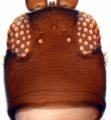Rhipidothrips brunneus
Recognition data
Distinguishing features
Both sexes fully winged or micropterous. Body, legs and antennae largely brown, tarsi yellow, also apex of tibiae and base of mid and hind femora; antennal segments I–II brown, III almost yellow; fore wing pale with posterior margin weakly shaded. Antennae 9-segmented, VII–IX forming a unit, segments III–IV with transverse sensorium at apex. Head longer than wide, with less than 5 pairs of small ante-ocellar setae, inter-ocellar setae prominent and arise on anterior margin of ocellar triangle; vertex sculptured. Pronotum with 1 pair of long posteroangular setae, 2 (or 3) pairs of posteromarginals. Mesonotum without microtrichia on sculpture lines. Metanotum with elongate reticulations in macropterae, but irregular sculpture in micropterae, without microtrichia, median setae near posterior margin. Fore tarsus with strongly recurved hamus. Fore wing with cross veins visible. Abdominal tergites with transverse reticulation, trichobothria on X about as large as major setal bases. Sternites III–VI with 2 or 3 pairs of posteromarginal setae, lateral pairs arise far forward on disc; sternite VII with 4 pairs of posteromarginal setae, 2 pairs of supernumerary setae, but without discal setae laterally.
Male tergite I with paired longitudinal ridges scarcely one third as long as tergite.
Related and similar species
Apart from this species that is widespread in Europe, there is a second Rhipidothrips species in western Europe between Finland and Spain, three further species are known from southeastern Europe, and one from the Mediterranean and the Canary Islands (zur Strassen, 2003).
Taxonomic data
Current valid name
Rhipidothrips brunneus Williams
Original name and synonyms
- Rhipidothrips brunneus Williams, 1913: 216
- Rhipidothrips cahirensis Priesner, 1932: 45
Family placement
Aeolothripidae
Biological data
Life history
Presumably predatory on other thrips (Bailey, 1954).
Host plants
Grasses, often in damp places.
Tospoviruses vectored
None
Crop damage
None recorded
Distribution data
Area of origin
Western Europe
Distribution
Widespread across western Europe to Egypt, also Western Australia and California.





